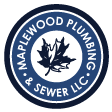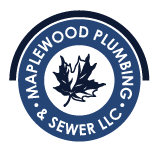
Think you might have a sewer line problem? If you’re like most homeowners, you probably don’t give much thought to the main sewer line running beneath your property… until there’s a problem.
The main sewer line plays a critical role in your home’s plumbing system, and problems with these sewer pipes can go from zero to emergency fast. That’s why it’s important to be on the lookout for red flags that could signal an issue with your sewer line so that you can contact a plumber before it gets worse.
Signs of Sewer Line Problems: 6 Red Flags You Need to Know
Catching the warning signs of sewer line issues early can save you time, money, and stress. How many of these red flags do you recognize in your home?
Red Flag #1: Multiple Clogged Drains
Are clogs becoming a recurring issue across multiple drains in your home? If sinks, showers, or toilets back up frequently—even after being cleared—this could indicate a deeper issue with your sewer line. Persistent toilet backups are a common clue that your plumbing system needs professional attention.
Red Flag #2: Slow-Moving Drains
When water takes longer than usual to drain or your toilet requires multiple flushes to clear, it’s a clear signal that something may be blocking your sewer line. Slow-moving drains shouldn’t be ignored, as they often indicate a growing problem that could escalate over time.
Red Flag #3: Unpleasant Odors
Notice a sewage-like smell coming from your sinks, toilets, showers, or even outside your home? This odor is a serious sign of a blockage in your sewer line. Wastewater that can’t flow freely through your pipes often creates a buildup that releases unpleasant odors. Don’t wait—contact a plumber immediately to prevent further damage.
Red Flag #4: Changes in Your Lawn
Your lawn may provide visual clues about a leaking sewer line. If you notice indentations or sinkholes appearing in your yard, it could mean the sewer line beneath is leaking. Additionally, spots of grass that suddenly look extra green and lush may be absorbing wastewater, which acts as a fertilizer. Both are strong indicators of a sewer line problem.
Red Flag #5: Strange Gurgling Noises
Is your toilet making unusual gurgling sounds when flushed, or do you hear odd noises when running appliances like your dishwasher or washing machine? These sounds often occur when air is trapped in the sewer line due to a blockage. Left unresolved, the issue could lead to more extensive plumbing problems.
Red Flag #6: Unusually High Water Bills
Have you noticed a sudden spike in your water bill without any changes to your usage? While higher bills during summer months might be expected if you’re watering the lawn or filling a pool, a sharp and unexplained increase could signal a sewer line leak. Monitoring your water bill can be an easy way to spot hidden plumbing issues.
What to Do If You Suspect a Sewer Line Problem
Recognizing the signs of a sewer line issue is just the first step. If you’ve noticed any of the red flags we’ve discussed—or worse, if you’re experiencing several of them—it’s time to call in a professional plumber. Early intervention can prevent minor issues from escalating into costly and disruptive repairs.
A licensed plumber will begin by performing a thorough camera inspection of your home’s main sewer line. This specialized process allows them to identify the precise location and cause of the problem, whether it’s deep within your property or along the line leading to your municipal sewer district (MSD).
5 Potential Causes of a Sewer Line Problem
Now, let’s look at five common culprits behind sewer line problems.
Cause #1: Tree Roots
Tree roots are a leading cause of sewer line damage. As water flows through your sewer pipes, small amounts of vapor escape into the surrounding soil. This vapor contains moisture, oxygen, and nutrients—everything trees need to thrive.
Much like tree branches naturally grow toward sunlight, tree roots are drawn to the source of this vapor. They’ll work their way toward the sewer line, finding entry through tiny cracks or loose pipe joints. Once inside, the roots expand, causing significant blockages or even pipe breakage.
If you have large trees on your property, scheduling regular sewer line inspections can help detect root intrusion before it becomes a major problem.
Cause #2: Broken or Dislodged Pipes
While sewer pipes made from durable materials like PVC are designed to last for decades (sometimes up to 100 years), they’re not immune to damage. Natural events such as ground shifting or tree root infiltration can crack, dislodge, or even break pipes.
In some cases, older pipes made from clay or cast iron are more susceptible to damage, but even newer PVC pipes can experience wear and tear under extreme conditions. A broken or misaligned pipe can disrupt the flow of wastewater, leading to backups or leaks that require professional repair.
Cause #3: Pipe Corrosion
The material of your home’s sewer line plays a major role in its longevity and vulnerability to corrosion.
- Cast Iron Pipes: Known for their long lifespan of nearly 100 years, cast iron pipes eventually succumb to rust, which leads to corrosion and pipe deterioration.
- Clay Pipes: These have a shorter lifespan and are prone to faster corrosion.
- PVC Pipes: While more resistant to corrosion, PVC pipes can still sustain damage that requires repair or replacement, especially if they’ve been in service for decades or experience severe blockages.
If corrosion weakens your sewer line, it can lead to leaks, collapses, and reduced efficiency, requiring immediate attention to avoid further damage.
Cause #4: Human Error
It’s easy to assume that hot grease or oil can safely go down your kitchen drain because it’s a liquid—but that’s a dangerous misconception. As grease, oil, and fat cool, they solidify, forming stubborn clogs that can accumulate over time. These substances are among the leading contributors to pipe blockages in residential plumbing systems.
Even garbage disposals can’t break down grease or fat properly. To avoid problems, always dispose of these materials in a heat-safe container and discard them in the trash. Routine drain cleaning and maintenance can help address buildup caused by improper disposal habits.
Cause #5: A Faulty Valve
Some sewer systems are equipped with a backwater valve, a critical component designed to prevent sewage from the public sewer system from backing up into your home. While these valves are incredibly effective, they require proper maintenance and regular inspections to function correctly.
Over time, debris, drain cleaning machines, or general wear and tear can damage these valves, leaving your home vulnerable to sewage backups. Ensuring your valve is inspected and maintained by a professional plumber can prevent unexpected failures.
Taking Action: Why Professional Help Matters
If you suspect a sewer line issue, acting quickly is essential. Left unaddressed, these problems can lead to costly repairs, property damage, and health hazards. A professional plumber has the tools, expertise, and technology needed to diagnose and resolve the problem effectively.
Here’s what you can expect from a professional sewer line service:
- Camera Inspection: This non-invasive method pinpoints the exact location and cause of the issue, allowing for a targeted solution.
- Tailored Repair Options: Whether the problem requires clearing a blockage, repairing a broken pipe, or replacing a corroded line, a skilled plumber will provide the best course of action.
- Preventive Advice: Professionals can recommend maintenance tips and solutions to help you avoid future sewer line problems.
Remember, early detection and professional intervention are the keys to keeping your plumbing system running smoothly and your home free from sewer-related disruptions. If you’ve noticed any of these causes in your home, don’t wait—contact Maplewood Plumbing today.
Comments are closed


